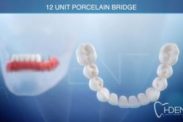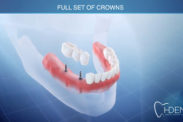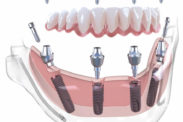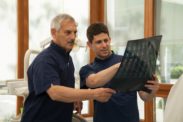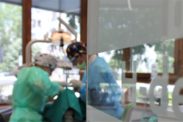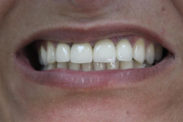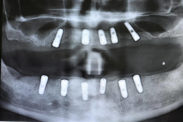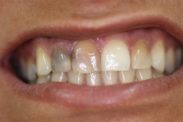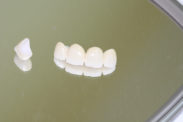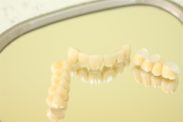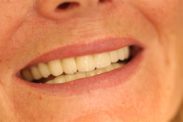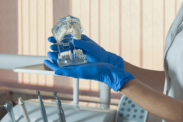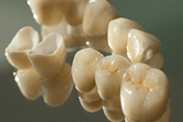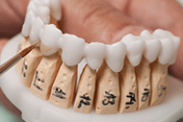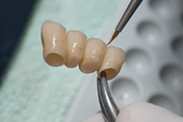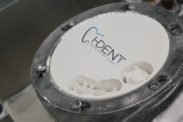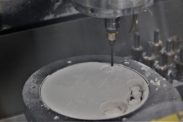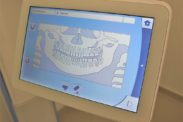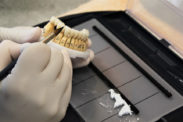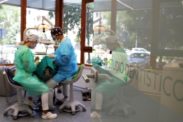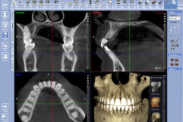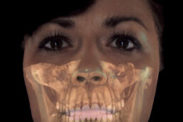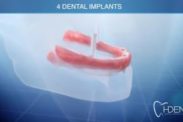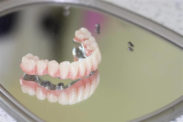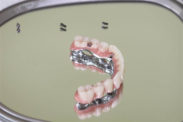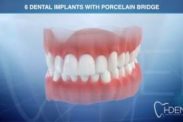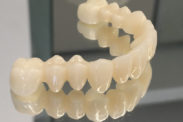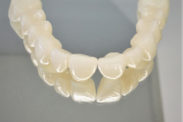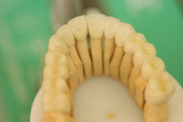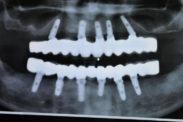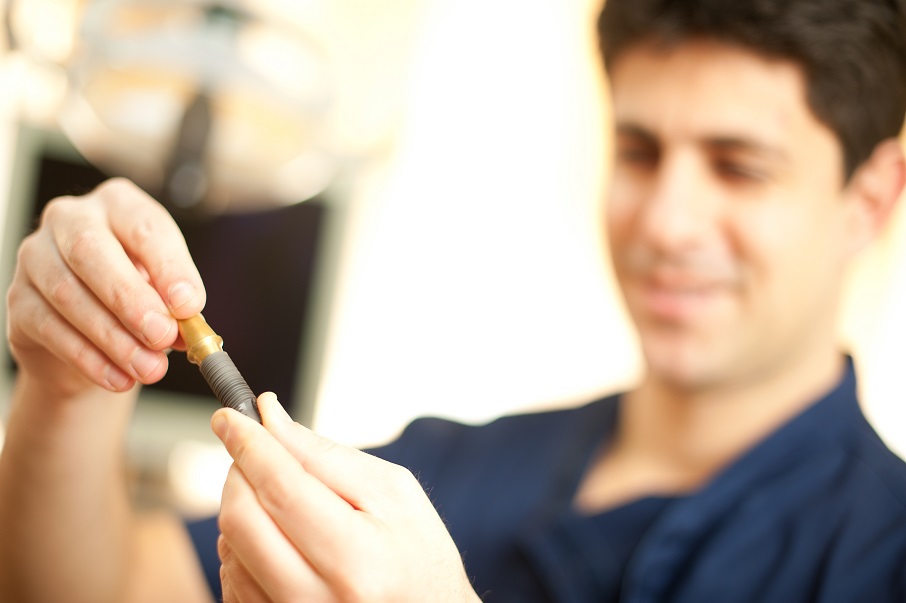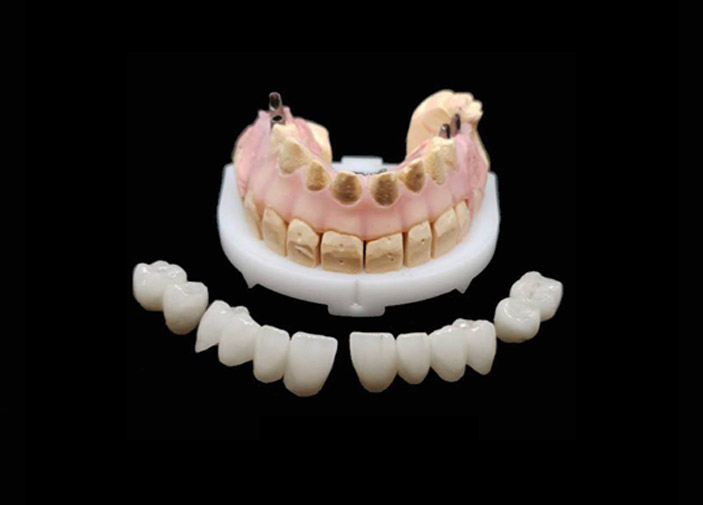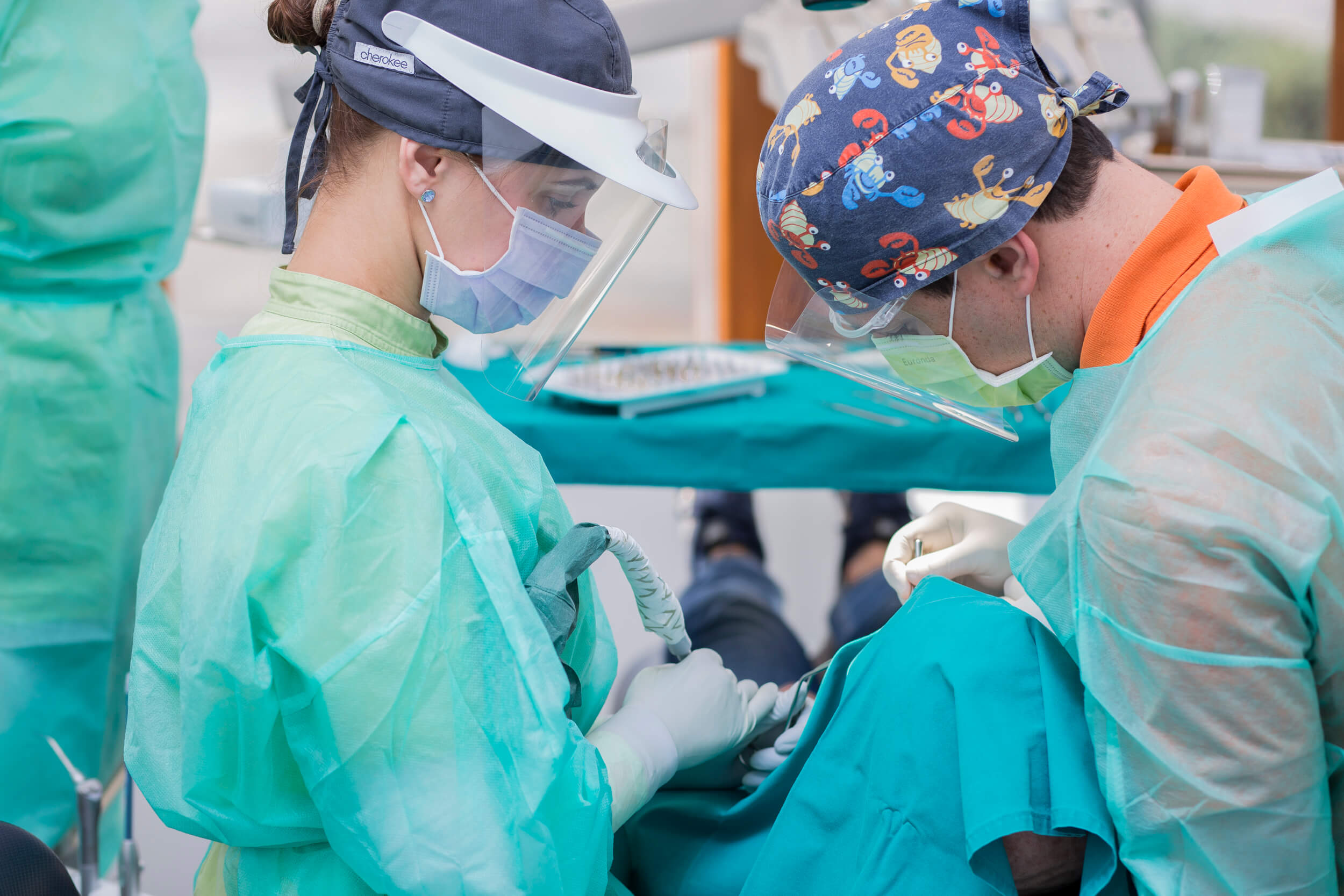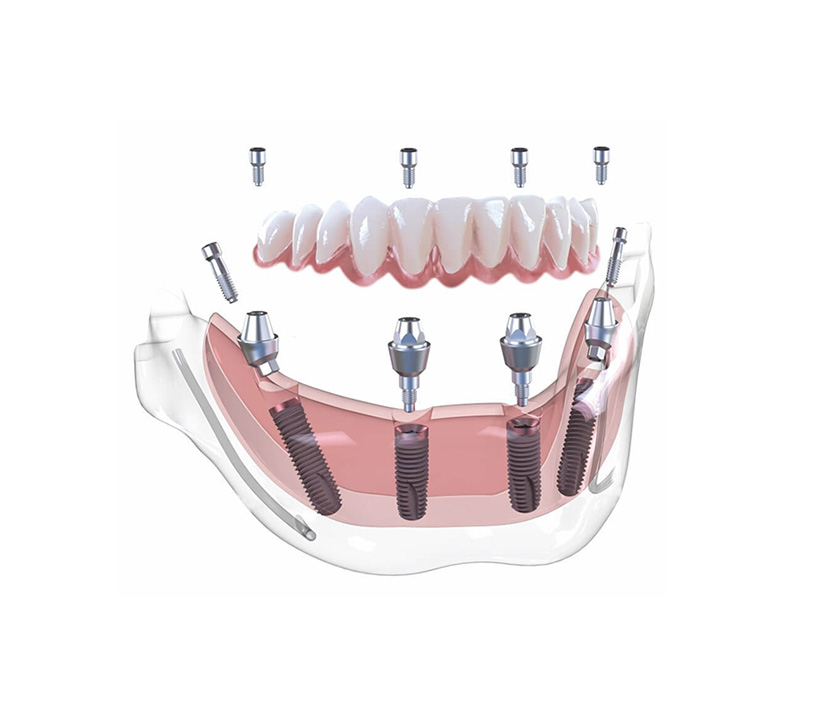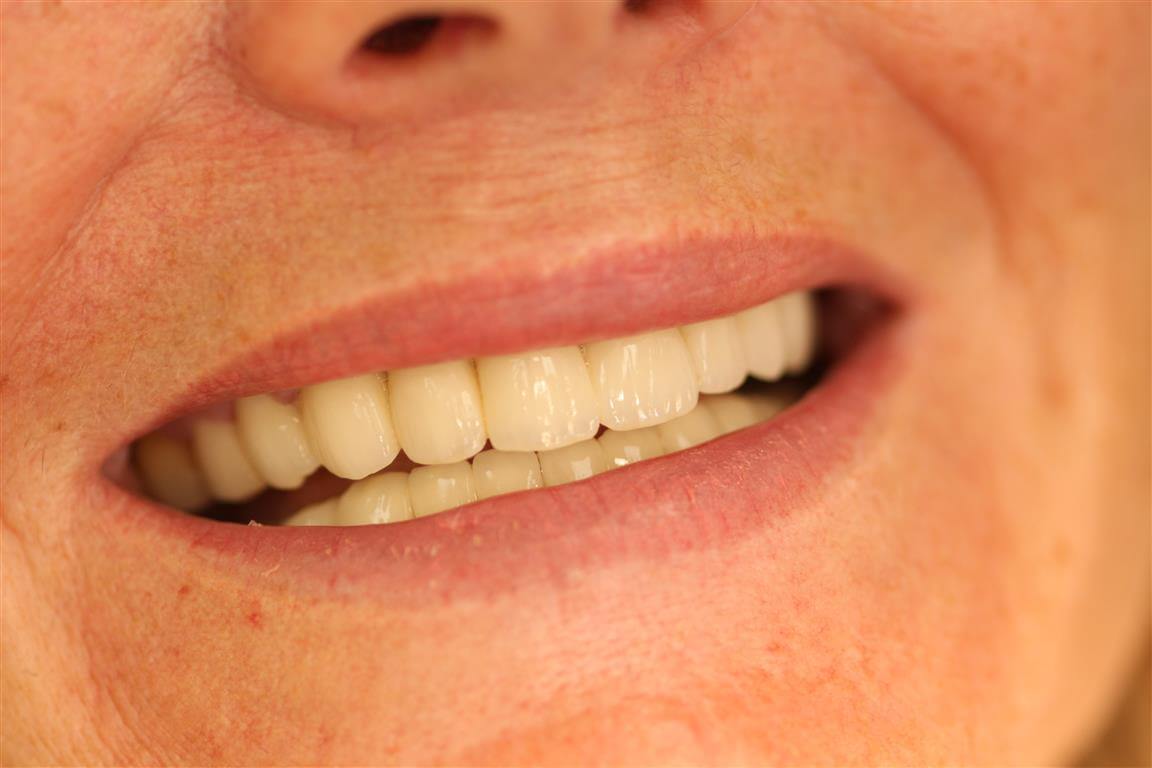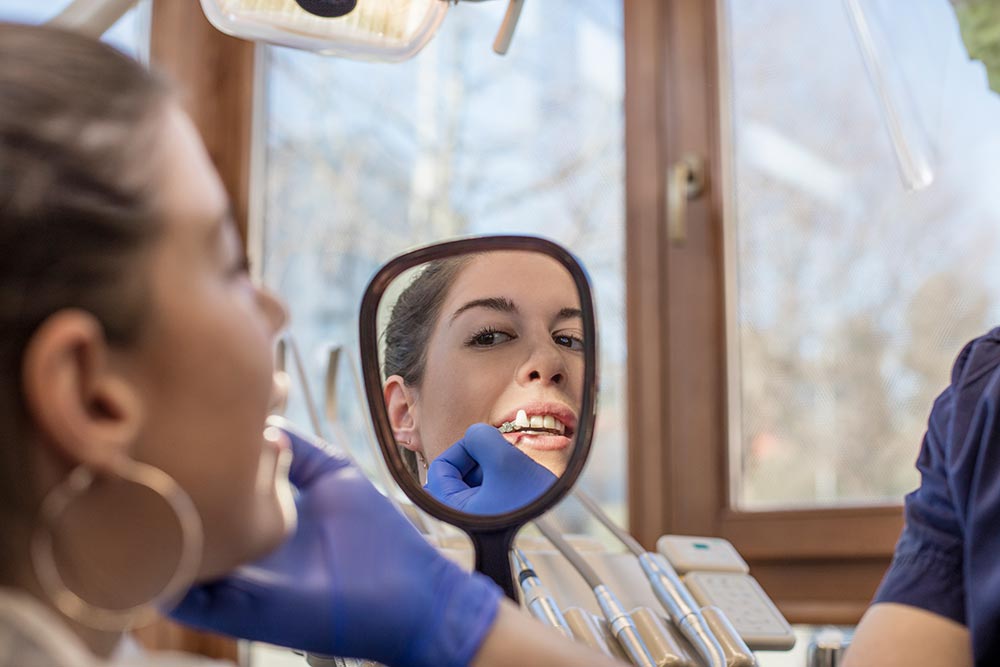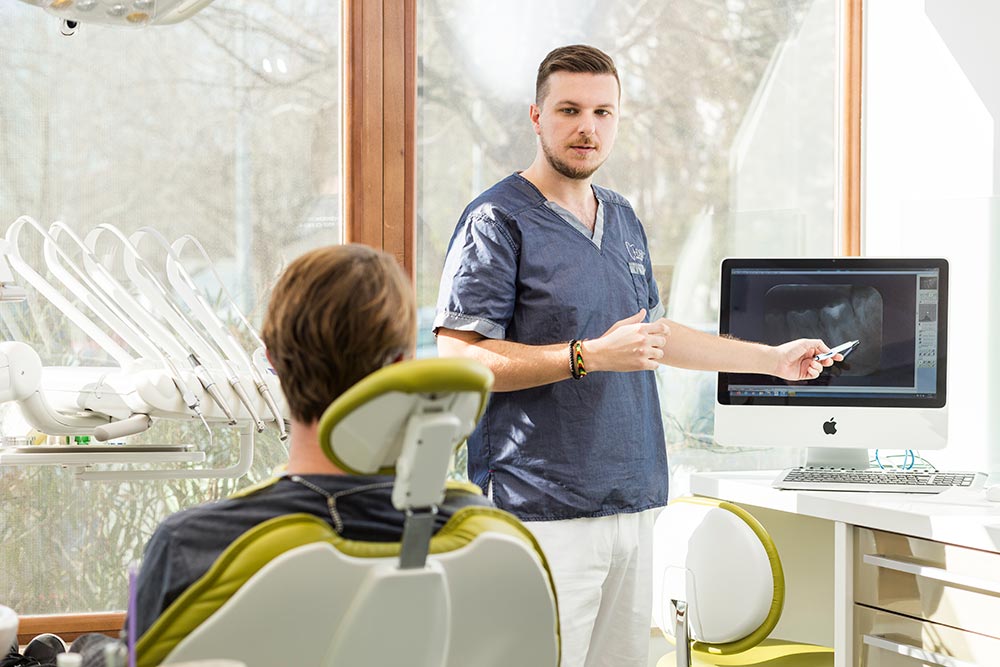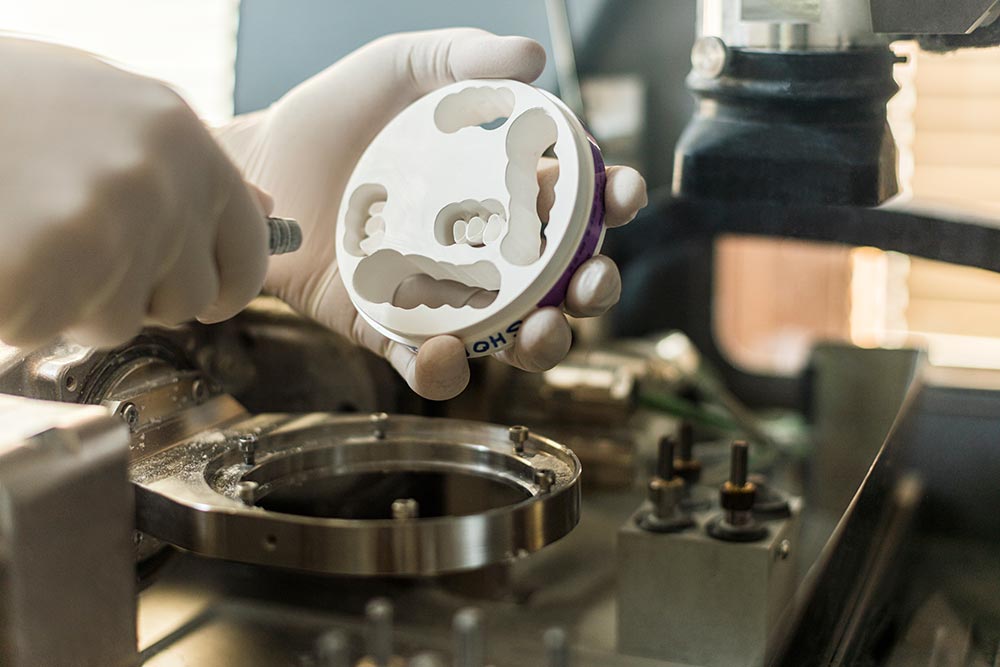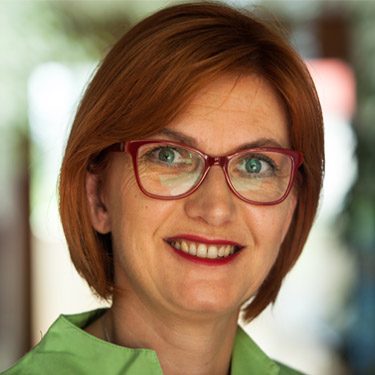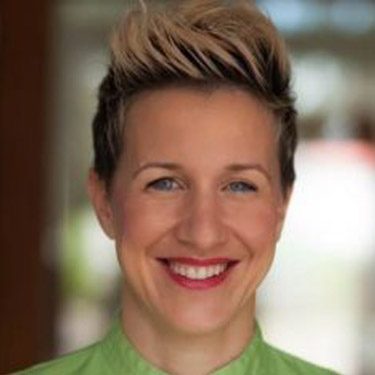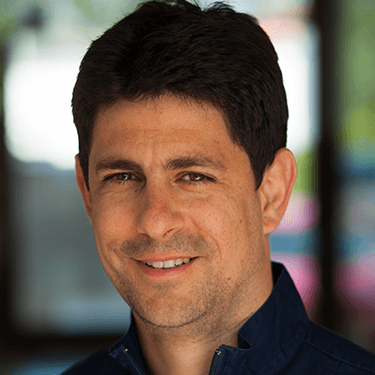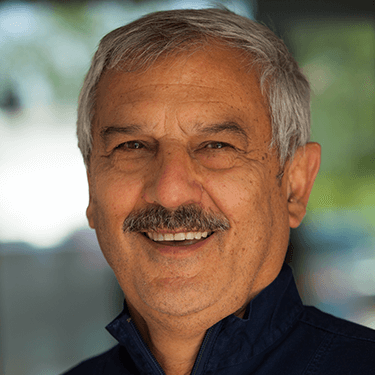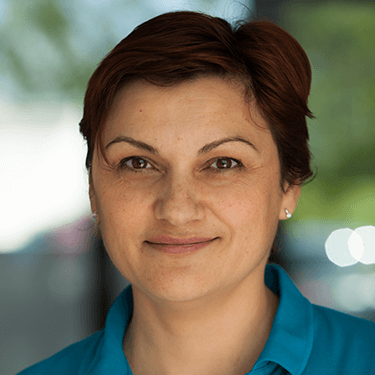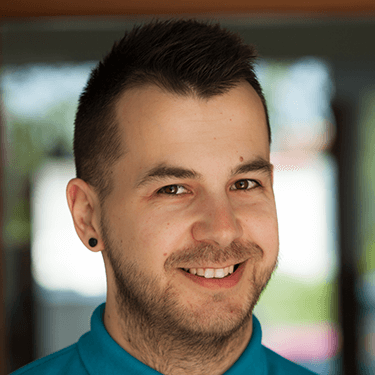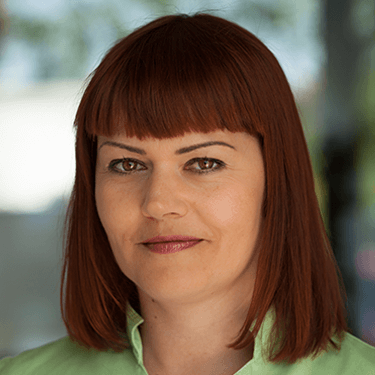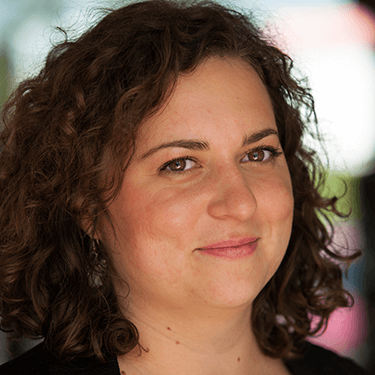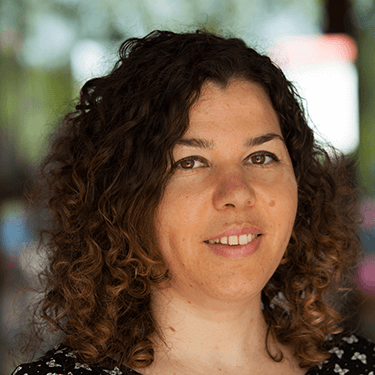What we do
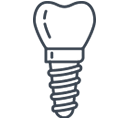
Dental Implants

Cosmetic dentistry

Crowns and bridges

Technology we use

All on 4

All on 6
DENTAL IMPLANTS
Dental Implants replace your missing teeth and feel as if you’ve got your natural teeth back. For this reason, implants are among the best solutions in cases of tooth replacement. They can replace one or more teeth, and are also used for stabilising and retaining dentures. Many patients, for various reasons, have trouble getting used to dentures. Fixed prosthetic works on implants resolve such issues. An implant consists of an artificial root which is implanted in the bone. After a period of time necessary for ossification, other parts are made, including a crown or a bridge. In any case, implants improve the quality of life. The advantages of implants reflect in the fact that they are independent and do not require honing the surrounding healthy teeth. Additionally, they contribute to the preservation of the bone. No other methods offer such advantages; for example, dentures accelerate the deterioration of the bone which makes them more uncomfortable and less stable in time.
WHAT ARE DENTAL IMPLANTS?
Dental implant serves as a root substitute for lost tooth. Modern dental implant is made from titanium and is like a screw made in different lengths and diameters. This dental implant is inserted to be part of the jaw bone and grows with it.
IN WHICH CASE PEOPLE USE DENTAL IMPLANT?
Dental implants are the best option for patients who have lost their teeth due to periodontal disease, because of dental treatment that gone wrong or because of a trauma or any other reason.
WHICH PATIENTS CAN DECIDE ON THIS KIND OF SURGERY?
Dental implant surgery is good option for everybody and there are no explicit contraindications. The ideal candidate for dental implants is a patient with good general health. Even patients with diabetes can go on dental implant surgery.
HOW MUCH DOES A DENTAL IMPLANT COST IN OUR DENTAL OFFICE?
Our dental office offers dental implants for only 550 Euro per implant. A dental implant with a titanium implant abutment and a final porcelain crown costs only 920€ with no hissed cost.
IS ADVANCED AGE A KIND OF PROBLEM FOR HAVING DENTAL IMPLANT?
Advanced age is not a problem for having dental implants. The only problem could be osteoporosis, but this should not be a contraindication if it doesn’t involve the jaw bones.
WHAT ARE THE ADVANTAGES OF DENTAL IMPLANTS OVER TRADITIONAL DENTURES AND DENTAL BRIDGES?
First advantage is that the look and a feeling that patients have with dental implants. It is identical to natural teeth. Dental implant can prevent bone loss and shrinkage of the rubber that occurs often to people with bad oral health. With dental implants you will regain back your confidence and be able to eat and speak normally.
HOW LONG DOES AN IMPLANT SURGERY TAKE?
The dental implant surgery is performed in two phases. In the first phase dentist begins with installing the dental implant into the bone. This implant is left from three to four months to heal or integrate with the jaw bone. After a few months dentist will install a dental crown or a bridge that will appear like natural teeth.
IS THE IMPLANST SURGERY PAINFUL?
In dental implants surgery, the patient is adequately anesthetized with local anaesthesia and will not feel pain. Patients are also given painkillers just to feel more comfortable.
AFTER THE SURGERY WILL I BE WITHOUT TEETH?
No, after dental implant surgery and a few days of healing dentist will provide you with a temporary denture.
AFTER DENTAL IMPLANTS SURGERY CAN I DRIVE ?
It is not recommended to drive after a surgery. At least sleep one day after the surgery and leave the next day. Our staff will always be ready to organise a nice room or apartment for you to stay.
COSMETIC DENTISTRY MEANS ACHIEVING A SMILE THAT WILL HAVE A POSITIVE IMPACT ON YOUR SELF-CONFIDENCE AND SELF-ESTEEM.
Cosmetic dentistry is a way we help people get a new smile. Weather you wish a white dazzling smile or a more conservative look, cosmetic dentistry will definitely mean new and improved appearance. If you were not born with the teeth you want, or if your smile has lost its sparkle due to ageing or the effects of drinking tea, coffee and red wine, cosmetic dentistry will help you smile with confidence again. Cosmetic dentistry involves many dental procedures (veneers, crowns or just whitening) with the aim of improving the overall aesthetics of your smile. Cosmetic dentistry today offers many options to help you achieve your beautiful and white smile.
DENTAL CROWNS
Dental crowns are made to help strengthen teeth and improve the appearance. Dental crowns are acting like a lid adding additional support to a weak tooth, helping to restore a tooth that is broken or to cover a dental implant.
DENTAL BRIDGES
Dental Bridge is made to replace missing teeth with artificial teeth. A fixed dental bridge contains artificial teeth that are made to be connected directly to the jaw or under the gum tissue. Fixed dental bridges can only be removed by a dentist. We offer also a removable dental bridge, which can be removed and cleaned from time to time. Usually these are dental bridges made on implants.
TOOTH WHITENING OR TEETH BLEACHING
Depending on your needs and your dental health history, we suggest a procedure in the office and we do not offer system that can be used at home. Our system is „Light cure whitening system“which enables that the whitening is being done in only 1 hour. Before starting patients must see one of our doctors to make sure the whitening is possible and prepare a patient for a specific treatment.
DENTAL VENEERS
Dental veneers are thin and custom made ‘shells’ which are intended to cover the front of teeth that are chipped, permanently stained or slightly crooked. Dental veneers are not good for back teeth.
DENTAL IMPLANTS
Dental implants are made to replace missing teeth with artificial teeth that look and feel like natural teeth. For this dental implants surgery, patients must be in good oral health and general health, must have healthy gums and sufficient bone structure to support the dental implant.
DENTURES
Dentures are another option for replacing missing teeth and this is also a cheapest way. Dentures are used when all or most of the patient’s natural teeth are lost.
CROWNS ARE VERY EFFICIENT SOLUTIONS FOR BADLY DETERIORATED TEETH
It can be made of pure ceramics or metal ceramics, and the choice will depend on the situation. A crown made of metal ceramics is the firmest solution due to its metal base, whereas the aesthetic momentum is gained with a crown made of pure ceramics or zirconium. The metal part of the crown follows the shape of the tooth, while ceramics imitate its natural shape, colour and firmness. The crown can be separate or a part of a bridge.
MAKING A CROWN!
The crown is made in two phases. During the first visit, the dentist hones the tooth and makes impressions to be sent to a dental lab, and the patient leaves the office with a temporary crown. When the patient returns for the second time, the crown is finished, fitted and permanently fixed. Dentist can use a single crown when they need a replacement to one tooth. Crowns can also be in block when patient need replacing of multiple teeths. The price of dental crown depends on the material from which the crown is made. For large crown bridges we use crowns made from metal-ceramic, and for so called aesthetic crowns we use zirconium crowns or full ceramic crowns. Crown are also used for dental implants. We also have temporary crowns made of plastic that very important for all patients waiting for final crowns to be prodused in our dental lab.
Dental bridge
Natural appearance and smile after losing a tooth can be regained by creating a bridge. Bridge fills the empty space in teeth sequence caused by the loss of a one or more teeth.
WHAT IS A BRIDGE?
A bridge consists of at least two teeth crowns, each on one side of the gap and a replacement tooth or teeth in the middle. The bridge can be created on your natural teeth, on implants or a combination of the two. The choice of your bridge will depend on the condition of your teeth, your finances and your aesthetic requirements.
Building a bridge
During the first visit, the dentist hones the carrying teeth and makes several impressions to be sent to a lab where the crowns and bridge are made. The patient leaves the office with temporary crowns. When the bridge or a crown is finished, the patient returns and the final product is applied. If there are no complications, the bridgework is permanently fixed.
With sufficient care, bridges and crowns will last for years. Brushing teeth and flossing on a daily basis are essential to the health of your teeth and gingiva, as well as to prosthetic works since such care extends their lifetime.
In our dental practice in most cases we use porcelain crowns or full ceramic/zirconium aesthetic crowns. These crowns are white in the visible surfaces with or without a thin metal parts invisible boundary, near the gingiva.
CAD CAM
CAD/CAM stands for Computer-Aided Design/Computer-Aided Manufacturing
A method which creates porcelain dental restorations in a matter of minutes instead of days. The computer program displays a 3-D custom images of teeth and gums, allowing dentists to precisely design the tooth restoration with functional and esthetic characteristics in mind. Once the restoration has been designed by the computer the information is sent to a milling machine which creates the restoration to the exact specifications of the design through CAM. The technology is so precise that dental restorations made by CAD/CAM often fit better than those made by hand in a dental lab. CAD/CAM dentistry technology is helping you move on faster than ever before. By using the CAD/CAM technology your dentist is in complete control of the final result.
Advantages of Cad Cam systems:
- – Increased accuracy
- – Milling equipment is typically accurate to 50 micrometres, CAD/CAM dental restorations are comparable in fit to traditionally fabricated dental restorations. Accuracy is critical, particularly since the fit of a restoration is the key to preventing future tooth damage.
- – Better long-term patient results
Since these types of restorations contain no metal to block subsequent x-rays, dentists are able to keep track of potential decay underneath a full zirconia restoration whereas conventional PFM or traditional gold crowns block x-ray radiation, disallowing such an evaluation over time.
As CAD/CAM enables dental practitioners to seat a finished restoration in a week’s time, practitioners find that treated patients have fewer side effects like tooth sensitivity following their dental treatment. There are many lab systems that help design and create copings and final restorations out of ceramics as well as metals. Zirconia is a popular material that comes in several varieties, in shades of white or yellow. When machined from blocks, their strength and accuracy allow these materials to be used as copings and bridge substructures without metal. Some of the CAD/CAM systems can create completed restorations using these materials.
CBCT
3D digital imaging is imperative for dental implant treatment to ensure accurate planning and safe surgery.
Implant surgery, as with any medical or dental intervention, requires careful planning to ensure no inadvertent damage is caused. 3D imaging allows us to look at your jaw bone from all angles on a computer screen and assess very carefully what surgical options are available to you.
This imaging also allows us to plan and complete your implant surgery with complete precision, ensuring that we can safely avoid any nerves or blood vessels in the region.
Beam Computed Tomography (CBCT) image, 3D facial photo and 3D model scan into one 3D image – using the same advanced software. This 3D combination creates a virtual patient in 3D, helping you with all your clinical needs.
This new technology provides more complete visual information to study your case from every angle. Best of all, the original scan data can be duplicated anytime to provide different specialists with images if needed later. For complex implant cases, this type of x-ray is the ultimate technology that allows your specialist not only “to have a look” at your specific anatomic conditions, but also to plan in advance a highly precise surgical solution. Cone beam x-rays help reduce the risk of complications, which in turn leads to more predictable and precise outcomes.
We’re the first company to combine three different types of 3D data with one X-ray unit. The Planmeca ProMax® 3D family brings together a Cone.
PIEZO SURGERY
Today there is a new kind of bone surgery available called Piezosurgery. This oral surgery is more precise than traditional surgery, resulting in little to no loss of bone or tissue. The reason for this is because Piezosurgery uses ultrasonic vibrations to cut through bone, instead of relying on traditional drilling methods. The ultrasonic vibrations are produced by a special machine that has been developed for the purpose.
Piezo surgery opens a wide range of indications, from normal scaling to periodontitis and implant cleaning, to all kind of endodontic and restorative treatments as well as extractions, thanks to an unequaled variety of 50 inserts – for every indications, every treatment and every situation you will face in the dental practice.
In the age of minimally invasive treatment, dental surgeons and oral and maxillofacial surgeons are increasingly using piezoelectric devices to prepare bone tissue. The technology is based on ultrasonic surgery and is ideal for atraumatic preparation of hard tissue.
PRF
Platelet Rich Fibrin is a by-product of blood that is exceptionally rich in platelets. PRF has long been used in hospitals to accelerate the body’s own healing process, but it is only fairly recently that advances in technology have allowed this same technique to be used in the dental office.
The blood platelets perform several essential functions in the body, including blood clot formation and the release of growth factors that help to heal wounds. These growth factors stimulate the stem cells to produce new host tissue as quickly as possible, which is why platelet rich fibrin is so effective in the post-treatment healing process.
There are several ways in which PRF can be used in clinical dentistry:
Bone Grafting For Implants – This includes sinus lifts, ridge augmentation.
Bone Repair – PRF can be used in facial trauma reconstruction, repairing of defects due to tooth removal, or the removal of growths and cysts.
Benefits of PRF Treatment with Tooth Extraction and Dental Implants:
- 1. Faster Healing
- 2. Less Pain
- 3. Decreased Swelling
- 4. Accelerated Healing of Bone to Dental Implants
- 5. Improved Strength of Bone Integration to Dental Implants
- 6. Decreased Chance of Dry Socket and Cavitations
- 7. Increased early blood supply to Tooth Extraction
- 8. SocketFacilitates Fast and Proper Healing of Wisdom Tooth Extraction Sites
All on 4
The ALL ON 4 technique involves the placement of a fixed denture on only four implants, the two posterior ones being positioned inclined to avoid maxillary sinuses and nerves. With this method you can avoid long and expensive regenerative procedures or zigomatic systems, much more expensive but mechanically more rational. This technique was developed after carefully studying the chewing forces mechanics and evaluating the most favorable positions, identifying the sites suitable for obtaining excellent primary stability with only four dental implants. It is an economical technique that allows replacement of a mobile prosthesis kept in the mouth by adhesive or adhesive powders or implant retentive systems, with a type of denture mounted on a bar that is screwed to the four implants and thus constitutes a fixed prosthesis. It also permits immediate loading. But it remains a very economical solution and not suitable for everyone.
Advantages of the All on four technique
• Only 4 implants for the rehabilitation of a complete dental arch (12 elements), of which the two rear implants are inclined by 30 °
• Avoid long cantilever extensions in the back areas
• Immediate loading (immediately fixed acrylic prosthesis)
In the upper jaw (maxilla), the inclined rear implants serve to:
• to avoid bone regeneration of the maxillary sinuses (eg. big maxillary sinus lift);
• or by inserting more apically and rearward, taking advantage of better quality bone presence;
• Possibility of inserting implants of greater length;
The lower jaw (mandibula) the inclined rear implants serves to:
• avoid inserting implants in the back area where there is frequently no good bone volume and where there is the mandibular canal inside in which is located the lower alveolar nerve;
• or by inserting more apically and rearward, they take advantage of the presence of good quality bone;
• or the possibility of inserting implants of greater length
All on 6
The ALL ON 6 method solves the problem of total edentuolism by replacing the missing teeth in the upper or lower jaw with a full-arch dental bridge supported by six dental implants. The bridge over 6 implants is an effective and pleasant solution with many advantages:
• treatment of the best quality with excellent aesthetic and functional result
• temporary teeth fixed in a single day
• natural feeling in the mouth
• bone preservation
• shorter treatment time frame
• high rate of treatment success
• improving the quality of life.
The patient regains fixed teeth that provides him a natural chewing sensation in the mouth and aestheticaly look like natural teeth. With this solution you can overcome once and for all the problem of old mobile prosthesis, stickers and shifts. This procedure is much more comfortable for patients, thanks to their fixed temporary teeth, which completely restore the functionality of chewing and aesthetics in a single session.
Services
We offer a wide range of services and benefits, this page shows all of the services we offer.


